Impact of Fire History on the Structure of a Temperate Forest in Northern Mexico
Abstract
1. Introduction
2. Materials and Methods
2.1. Study Area
2.2. Data Collection
2.3. Fire Reconstruction
2.4. Seasonality of Fires
2.5. Determination of Tree Age
2.6. Fire Interval Analysis
2.7. Climate–Fire Relationship
- (1)
- The number of rainy days in the December–February period [35];
- (2)
- Instrumental values of Palmer’s Drought Severity Index (PDSI) for May [36]; and
- (3)
- El Niño 3 Sea Surface Temperature (SST) index values for June-August (NOAA, https://psl.noaa.gov/data/climateindices/list/; accessed on 2 December 2022).
2.8. Relationship of Tree Age Structure with Forest Fires and Climate
3. Results
3.1. Fire History
3.2. Fire Intervals
3.3. Seasonality of Fires
3.4. Climate–Fire Relationship
3.5. Relationship of Tree Age Structure with Forest Fires and Climate
4. Discussion
4.1. Fire History
4.2. Frequency of Fires
4.3. Fire Seasonality
4.4. Climate-Fire Relationship
4.5. Relationship of Tree Age Structure with Forest Fires and Climate
4.6. Management Considerations
5. Conclusions
Author Contributions
Funding
Institutional Review Board Statement
Informed Consent Statement
Data Availability Statement
Acknowledgments
Conflicts of Interest
References
- Whitehair, L.; Fulé, P.Z.; Meador, A.S.; Azpeleta Tarancón, A.; Kim, Y.-S. Fire Regime on a Cultural Landscape: Navajo Nation. Ecol. Evol. 2018, 8, 9848–9858. [Google Scholar] [CrossRef] [PubMed]
- Fulé, P.Z. Fire Regimes and Forest Structure in Pine Ecosystems of Arizona, United States, and Durango, Mexico; Northern Arizona University: Flagstaff, AZ, USA, 1996. [Google Scholar]
- Welch, K.R.; Safford, H.D.; Young, T.P. Predicting Conifer Establishment Post Wildfire in Mixed Conifer Forests of the North American Mediterranean-Climate Zone. Ecosphere 2016, 7, e01609. [Google Scholar] [CrossRef]
- González-Elizondo, M.; González-Elizondo, M.; Tena-Flores, J.A.; López-Enríquez, L.; Ruacho-González, L. Vegetación de La Sierra Madre Occidental, México: Una Síntesis. Acta Botánica Mex. 2012, 100, 351–403. [Google Scholar] [CrossRef]
- Rzedowski, J. Vegetación de México; 1st Edition; Comisión Nacional para el Conocimiento y Uso de la Biodiversidad: Mexico City, Mexico, 2006. [Google Scholar]
- Heyerdahl, E.K.; Alvarado, E. Influence of Climate and Land Use on Historical Surface Fires in Pine-Oak Forests, Sierra Madre Occidental, Mexico BT-Fire and Climatic Change in Temperate Ecosystems of the Western Americas; Veblen, T.T., Baker, W.L., Montenegro, G., Swetnam, T.W., Eds.; Springer: New York, NY, USA, 2003; pp. 196–217. ISBN 978-0-387-21710-9. [Google Scholar]
- Cerano-Paredes, J.; Iniguez, J.M.; González-Castañeda, J.L.; Cervantes-Martínez, R.; Cambrón-Sandoval, V.H.; Esquivel-Arriaga, G.; Nájera-Luna, J.A. Increasing the Risk of Severe Wildfires in San Dimas, Durango, Mexico Caused by Fire Suppression in the Last 60 Years. Front. For. Glob. Chang. 2022, 5, 940302. [Google Scholar] [CrossRef]
- Stevens, J.T.; Safford, H.D.; North, M.P.; Fried, J.S.; Gray, A.N.; Brown, P.M.; Dolanc, C.R.; Dobrowski, S.Z.; Falk, D.A.; Farris, C.A.; et al. Average Stand Age from Forest Inventory Plots Does Not Describe Historical Fire Regimes in Ponderosa Pine and Mixed-Conifer Forests of Western North America. PLoS ONE 2016, 11, e0147688. [Google Scholar] [CrossRef]
- Grissino-Mayer, H.D. FHX2-Software for Analyzing Temporal and Spatial Patterns in Fire Regimes from Tree Rings. Tree-Ring Res. 2001, 57, 115–124. [Google Scholar]
- Wang, X.-C.; Ying, J.I. Review of Advances in Dendropyrochronology. Chin. J. Plant Ecol. 2009, 33, 587–597. [Google Scholar]
- Lafon, C.W.; Naito, A.T.; Grissino-Mayer, H.D.; Horn, S.P.; Waldrop, T.A. Fire History of the Appalachian Region: A Review and Synthesis; U.S. Department of Agriculture, Forest Service, Southern Research Station: Washington, DC, USA, 2017.
- Duncan, R.P.; Stewart, G.H. The Temporal and Spatial Analysis of Tree Age Distributions. Can. J. For. Res. 1991, 21, 1703–1710. [Google Scholar] [CrossRef]
- Clark, J.S. Disturbance and Population Structure on the Shifting Mosaic Landscape. Ecology 1991, 72, 1119–1137. [Google Scholar] [CrossRef]
- Sáenz-Ceja, J.E.; Pérez-Salicrup, D.R. Modification of Fire Regimes Inferred from the Age Structure of Two Conifer Species in a Tropical Montane Forest, Mexico. Forests 2020, 11, 1193. [Google Scholar] [CrossRef]
- Iniguez, J.M.; Swetnam, T.W.; Baisan, C.H. Fire History and Moisture Influences on Historical Forest Age Structure in the Sky Islands of Southern Arizona, USA. J. Biogeogr. 2016, 43, 85–95. [Google Scholar] [CrossRef]
- Fule, P.Z.; Covington, W.W. Fire regimes and forest structure in the Sierra Madre Occidental, Durango, Mexico. Acta Bot. Mex. 1997, 41, 43–79. [Google Scholar] [CrossRef]
- Fulé, P.Z.; Covington, W.W. Fire Regime Changes in La Michilía Biosphere Reserve, Durango, Mexico. Conserv. Biol. 1999, 13, 640–652. [Google Scholar] [CrossRef]
- Cortés Montaño, C.; Fulé, P.Z.; Falk, D.A.; Villanueva-Díaz, J.; Yocom, L.L. Linking Old-Growth Forest Composition, Structure, Fire History, Climate and Land-Use in the Mountains of Northern México. Ecosphere 2012, 3, art106. [Google Scholar] [CrossRef]
- Meunier, J.; Brown, P.M.; Romme, W.H. Tree Recruitment in Relation to Climate and Fire in Northern Mexico. Ecology 2014, 95, 197–209. [Google Scholar] [CrossRef]
- Sáenz-Ceja, J.E.; Pérez-Salicrup, D.R. The Role of Fire in the Regeneration of Conifer Forests. Rev. Chapingo Ser. Ciencias For. y del Ambient. 2019, 25, 123–139. [Google Scholar] [CrossRef]
- Silver, E.J.; Speer, J.H.; Kaye, M.; Reo, N.J.; Howard, L.F.; Anning, A.K.; Wood, S.W.; Wilbur, H.M. Fire History and Age Structure of an Oakpine Forest on Price Mountain, Virginia, USA. Nat. Areas J. 2013, 33, 440–446. [Google Scholar] [CrossRef]
- García, E. Modificaciones Al Sistema de Clasificación Climática de Köppen, 5th ed.; Universidad Autónoma de México, Instituto de Geografía: Ciudad de México, Mexico, 2004. [Google Scholar]
- Instituto Nacional de Estadística y Geografía (INEGI). Anuario Estadístico y Geográfico de Durango 2017; Instituto Nacional de Estadística y Geografía (INEGI): Mexico City, Mexico, 2017. [Google Scholar]
- González-Elizondo, M.S.; González-Elizondo, M.; Márquez, L.M.A. Vegetación y Ecorregiones de Durango; 1st ed.; CIIDIR Unidad Durango Instituto Politécnico Nacional: Durango, Mexico, 2006. [Google Scholar]
- Cerano-Paredes, J.; Iniguez, J.M.; Cardoza-Martínez, G.F.; Villanueva-Díaz, J.; Cervantes-Martínez, R.; Cambrón-Sandoval, V.H.; Estrada-Arellano, J.R.; Esquivel-Arriaga, G.; Cardoza-Martínez, G.F.; Franco-Ramos, O.; et al. Using Tree-Rings to Reconstruct Fire History Information from Forested Areas. JoVE 2020, 164, e61698. [Google Scholar] [CrossRef] [PubMed]
- Arno, S.F.; Sneck, K.M. A Method for Determining Fire History in Coniferous Forests of the Mountain West; Department of Agriculture, Forest Service, Intermountain Forest and Range Experiment Station: Ogden, UT, USA, 1977. [Google Scholar]
- Stokes, M.A.; Smiley, T.L. Introduction to Tree-Ring Dating; University of Chicago Press: Chicago, IL, USA, 1968. [Google Scholar]
- Robinson, W.J.; Evans, R. A Microcomputer-Based Tree-Ring Measuring System. Tree-Ring Bull. 1980, 40, 59–64. [Google Scholar]
- Holmes, R.L. Computer-Assisted Quality Control in Tree-Ring Dating and Measurement. Tree-Ring Bull. 1983, 43, 51–67. [Google Scholar]
- Dieterich, J.H.; Swetnam, T.W. Dendrochronology of a Fire-Scarred Ponderosa Pine. For. Sci. 1984, 30, 238–247. [Google Scholar] [CrossRef]
- Baisan, C.H.; Swetnam, T.W. Fire History on a Desert Mountain Range: Rincon Mountain Wilderness, Arizona, U.S.A. Can. J. For. Res. 1990, 20, 1559–1569. [Google Scholar] [CrossRef]
- Applequist, M.B. A Simple Pith Locator for Use with Off-Center Increment Cores. J. For. 1958, 56, 138–143. [Google Scholar] [CrossRef]
- Sutherland, E.K.; Brewer, P.W.; Falk, D.A.; Velásquez, E.M. FHAES, Fire History Analysis and Exploration System; Missoula Forestry Sciences Laboratory: Missoula, MT, USA, 2017. [Google Scholar]
- Swetnam, T.W.; Baisan, C.H. Tree-Ring Reconstructions of Fire and Climate History in the Sierra Nevada and Southwestern United States BT-Fire and Climatic Change in Temperate Ecosystems of the Western Americas; Veblen, T.T., Baker, W.L., Montenegro, G., Swetnam, T.W., Eds.; Springer: New York, NY, USA, 2003; pp. 158–195. ISBN 978-0-387-21710-9. [Google Scholar]
- Comisión Nacional del Agua, (CONAGUA). Normales Climatológicas Por Estado; Comisión Nacional del Agua: Mexico City, Mexico, 2022. [Google Scholar]
- Stahle, D.W.; Cook, E.R.; Burnette, D.J.; Villanueva, J.; Cerano, J.; Burns, J.N.; Griffin, D.; Cook, B.I.; Acuña, R.; Torbenson, M.C.A.; et al. The Mexican Drought Atlas: Tree-Ring Reconstructions of the Soil Moisture Balance during the Late Pre-Hispanic, Colonial, and Modern Eras. Quat. Sci. Rev. 2016, 149, 34–60. [Google Scholar] [CrossRef]
- Margolis, E.Q.; Guiterman, C.H.; Chavardès, R.D.; Coop, J.D.; Copes-Gerbitz, K.; Dawe, D.A.; Falk, D.A.; Johnston, J.D.; Larson, E.; Li, H.; et al. The North American Tree-Ring Fire-Scar Network. Ecosphere 2022, 13, e4159. [Google Scholar] [CrossRef]
- Sáenz-Ceja, J.E.; Martínez-Ramos, M.; Mendoza, M.E.; Pérez-Salicrup, D.R. Fire Scar Characteristics in Two Tropical Montane Conifer Species from Central Mexico. Int. J. Wildl. Fire 2022, 31, 684–692. [Google Scholar] [CrossRef]
- Hahn, G.E.; Coates, T.A.; Aust, W.M.; Bolding, M.C.; Thomas-Van Gundy, M.A. Long-Term Impacts of Silvicultural Treatments on Wildland Fuels and Modeled Fire Behavior in the Ridge and Valley Province, Virginia (USA). For. Ecol. Manag. 2021, 496, 119475. [Google Scholar] [CrossRef]
- Cerano-Paredes, J.; Villanueva-Díaz, J.; Vázquez-Selem, L.; Cervantes-Martínez, R.; Magaña-Rueda, V.O.; Constante-García, V.; Esquivel-Arriaga, G.; Valdez-Cepeda, R.D. Climatic Influence on Fire Regime (1700 to 2008) in the Nazas Watershed, Durango, Mexico. Fire Ecol. 2019, 15, 9. [Google Scholar] [CrossRef]
- Rosales-Mata, S. Reconstrucción de Precipitación e Incendios En Bosques de Coníferas En El Ejido Adolfo Ruiz Cortines, Pueblo Nuevo, Durango; Universidad Autónoma de Nuevo León: Linares, Nuevo León, Mexico, 2016. [Google Scholar]
- Cerano-Paredes, J.; Villanueva-Díaz, J.; Fulé, P.Z. Reconstrucción de Incendios y Su Relación Con El Clima Para La Reserva Cerro El Mohinora, Chihuahua. Rev. Mex. Ciencias For. 2010, 1, 63–74. [Google Scholar]
- Sáenz-Ceja, J.E.; Pérez-Salicrup, D.R. Dendrochronological Reconstruction of Fire History in Coniferous Forests in the Monarch Butterfly Biosphere Reserve, Mexico. Fire Ecol. 2019, 15, 18. [Google Scholar] [CrossRef]
- Poulos, H.M.; Villanueva Díaz, J.; Cerano Paredes, J.; Camp, A.E.; Gatewood, R.G. Human Influences on Fire Regimes and Forest Structure in the Chihuahuan Desert Borderlands. For. Ecol. Manag. 2013, 298, 1–11. [Google Scholar] [CrossRef]
- Zúñiga-Vásquez, J.M.; Pompa-García, M. The Occurrence of Forest Fires in Mexico Presents an Altitudinal Tendency: A Geospatial Analysis. Nat. Hazards 2019, 96, 213–224. [Google Scholar] [CrossRef]
- Rodríguez-Trejo, D.A.; Fulé, P.Z. Fire Ecology of Mexican Pines and a Fire Management Proposal. Int. J. Wildl. Fire 2003, 12, 23–37. [Google Scholar] [CrossRef]
- Keeley, J.E.; Syphard, A.D. Climate Change and Future Fire Regimes: Examples from California. Geosciences 2016, 6, 37. [Google Scholar] [CrossRef]
- Yocom Kent, L.L.; Fulé, P.Z.; Brown, P.M.; Cerano-Paredes, J.; Cornejo-Oviedo, E.; Cortés Montaño, C.; Drury, S.A.; Falk, D.A.; Meunier, J.; Poulos, H.M.; et al. Climate Drives Fire Synchrony but Local Factors Control Fire Regime Change in Northern Mexico. Ecosphere 2017, 8, e01709. [Google Scholar] [CrossRef]
- Zúñiga-Vásquez, J.M.; Cisneros-González, D.; Pompa-García, M. Drought Regulates the Burned Forest Areas in Mexico: The Case of 2011, a Record Year. Geocarto Int. 2019, 34, 560–573. [Google Scholar] [CrossRef]
- Magaña, V.O.; Vázquez, J.L.; Pérez, J.L.; Pérez, J.B. Impact of El Niño on precipitation in Mexico. Geofísica Int. 2003, 42, 313–330. [Google Scholar]
- Yocom, L.L.; Fulé, P.Z.; Brown, P.M.; Cerano, J.; Villanueva-Díaz, J.; Falk, D.A.; Cornejo-Oviedo, E. El Niño–Southern Oscillation Effect on a Fire Regime in Northeastern Mexico Has Changed over Time. Ecology 2010, 91, 1660–1671. [Google Scholar] [CrossRef]
- Pickett, S.T.A.; White, P.S. The Ecology of Natural Disturbance and Patch Dynamics; Academic Press: Cambridge, MA, USA, 1985; ISBN 0125545207. [Google Scholar]
- Fulé, P.Z.; Laughlin, D.C. Wildland Fire Effects on Forest Structure over an Altitudinal Gradient, Grand Canyon National Park, USA. J. Appl. Ecol. 2007, 44, 136–146. [Google Scholar] [CrossRef]
- Hayes, J.J.; Robeson, S.M. Relationships between Fire Severity and Post-Fire Landscape Pattern Following a Large Mixed-Severity Fire in the Valle Vidal, New Mexico, USA. For. Ecol. Manag. 2011, 261, 1392–1400. [Google Scholar] [CrossRef]
- McLauchlan, K.K.; Higuera, P.E.; Miesel, J.; Rogers, B.M.; Schweitzer, J.; Shuman, J.K.; Tepley, A.J.; Varner, J.M.; Veblen, T.T.; Adalsteinsson, S.A.; et al. Fire as a Fundamental Ecological Process: Research Advances and Frontiers. J. Ecol. 2020, 108, 2047–2069. [Google Scholar] [CrossRef]
- Kemp, K.B.; Higuera, P.E.; Morgan, P. Fire Legacies Impact Conifer Regeneration across Environmental Gradients in the U.S. Northern Rockies. Landsc. Ecol. 2016, 31, 619–636. [Google Scholar] [CrossRef]
- Stevens-Rumann, C.S.; Kemp, K.B.; Higuera, P.E.; Harvey, B.J.; Rother, M.T.; Donato, D.C.; Morgan, P.; Veblen, T.T. Evidence for Declining Forest Resilience to Wildfires under Climate Change. Ecol. Lett. 2018, 21, 243–252. [Google Scholar] [CrossRef] [PubMed]
- Alfaro Reyna, T.; Martínez-Vilalta, J.; Retana, J. Regeneration Patterns in Mexican Pine-Oak Forests. For. Ecosyst. 2019, 6, 50. [Google Scholar] [CrossRef]
- Zúñiga-Vásquez, J.M.; Villanueva-Díaz, J.; Cerano-Paredes, J.; Quiñonez-Barraza, G. Effect of Fire Severity on the Species Diversity and Structure of a Temperate Forest in Northern Mexico. Forests 2022, 13, 1121. [Google Scholar] [CrossRef]
- Tepley, A.J.; Swanson, F.J.; Spies, T.A. Fire-Mediated Pathways of Stand Development in Douglas-Fir/Western Hemlock Forests of the Pacific Northwest, USA. Ecology 2013, 94, 1729–1743. [Google Scholar] [CrossRef] [PubMed]
- Hankin, L.E.; Higuera, P.E.; Davis, K.T.; Dobrowski, S.Z. Impacts of Growing-Season Climate on Tree Growth and Post-Fire Regeneration in Ponderosa Pine and Douglas-Fir Forests. Ecosphere 2019, 10, e02679. [Google Scholar] [CrossRef]
- Rodríguez-Trejo, D.A.; Martínez-Muñoz, P.; Pulido-Luna, J.A.; Martínez-Lara, P.J.; Cruz-López, J.D. Instructivo de Quemas Prescritas Para El Manejo Integral Del Fuego En El Municipio de Villaflores y La Reserva de La Biosfera La Sepultura, Chiapas; Fondo Mexicano para la Conservación de la Naturaleza, USDA FS, US AID, SEMARNAT, Biomas A.C., Universidad Autónoma Chapingo, Ayuntamiento de Villaflores, CONAFOR, CONANP, Gobierno del Estado de Chiapas, ANFC: Chiapas, Mexico, 2019. [Google Scholar]
- Stephens, S.; Agee, J.; Fulé, P.; North, M.; Romme, W.; Swetnam, T.; Turner, M. Managing Forests and Fire in Changing Climates. Science 2013, 342, 41–42. [Google Scholar] [CrossRef]
- Stevens-Rumann, C.S.; Morgan, P. Tree Regeneration Following Wildfires in the Western US: A Review. Fire Ecol. 2019, 15, 15. [Google Scholar] [CrossRef]
- Kemp, K.B.; Higuera, P.E.; Morgan, P.; Abatzoglou, J.T. Climate Will Increasingly Determine Post-Fire Tree Regeneration Success in Low-Elevation Forests, Northern Rockies, USA. Ecosphere 2019, 10, e02568. [Google Scholar] [CrossRef]
- Diario Oficial de la Federación (DOF). Ley General De Desarrollo Forestal Sustentable; Diario Oficial de la Federación (DOF): Mexico City, Mexico, 2018. [Google Scholar]
- Ouzts, J.; Kolb, T.; Huffman, D.; Sánchez Meador, A. Post-Fire Ponderosa Pine Regeneration with and without Planting in Arizona and New Mexico. For. Ecol. Manag. 2015, 354, 281–290. [Google Scholar] [CrossRef]
- Hammond, D.H.; Strand, E.K.; Morgan, P.; Hudak, A.T.; Newingham, B.A. Environmental Influences on Density and Height Growth of Natural Ponderosa Pine Regeneration Following Wildfires. Fire 2021, 4, 80. [Google Scholar] [CrossRef]
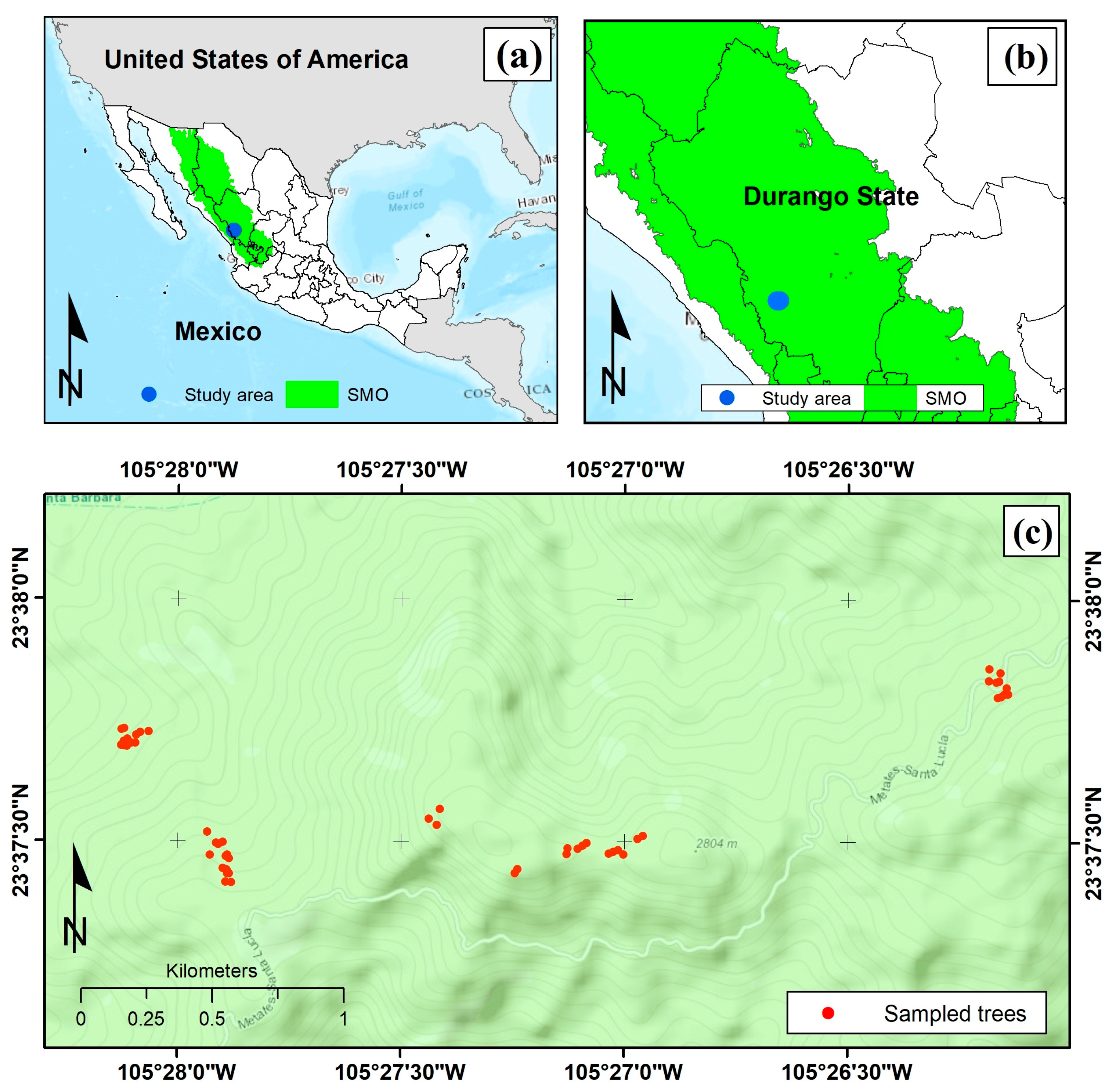
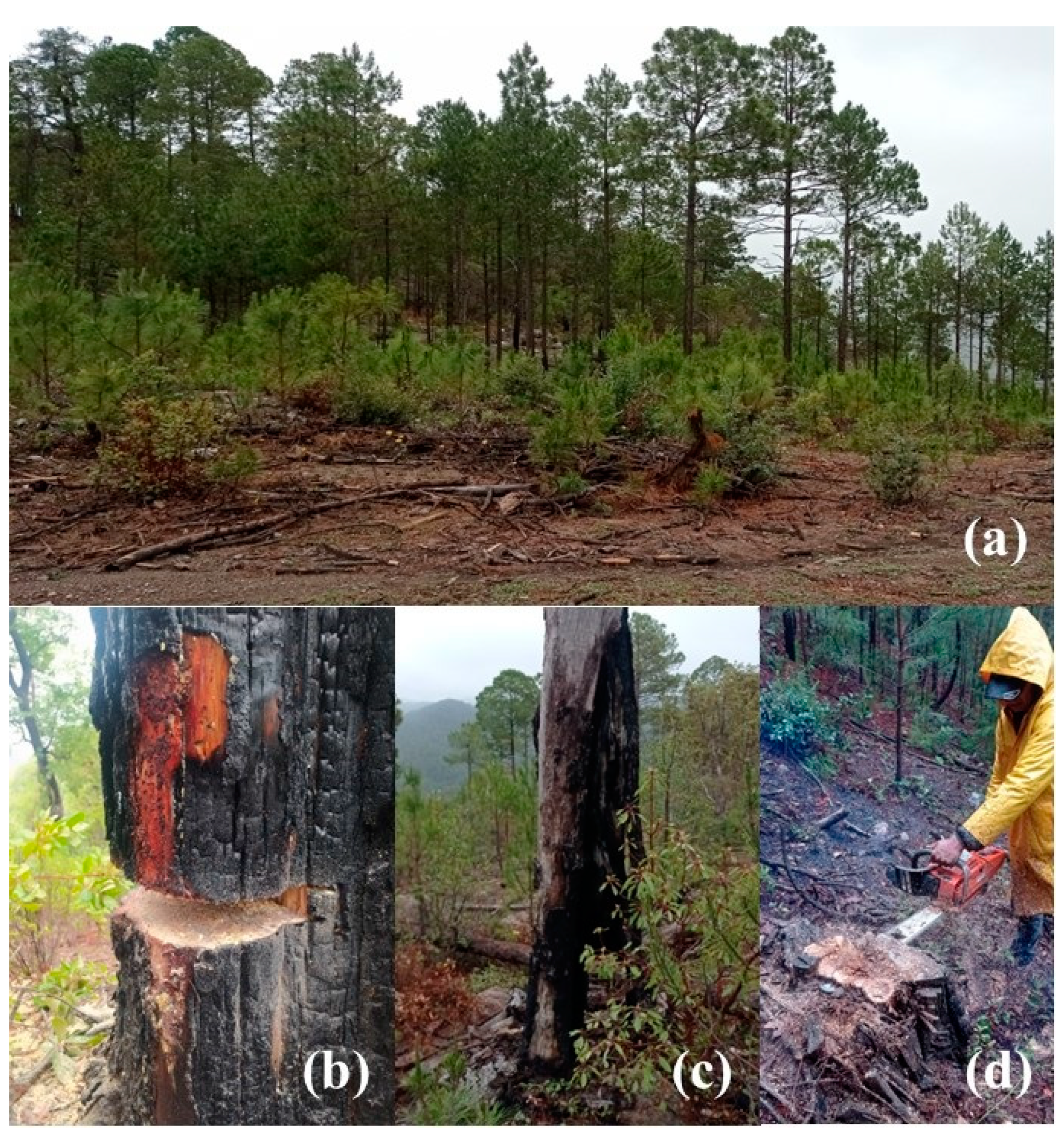
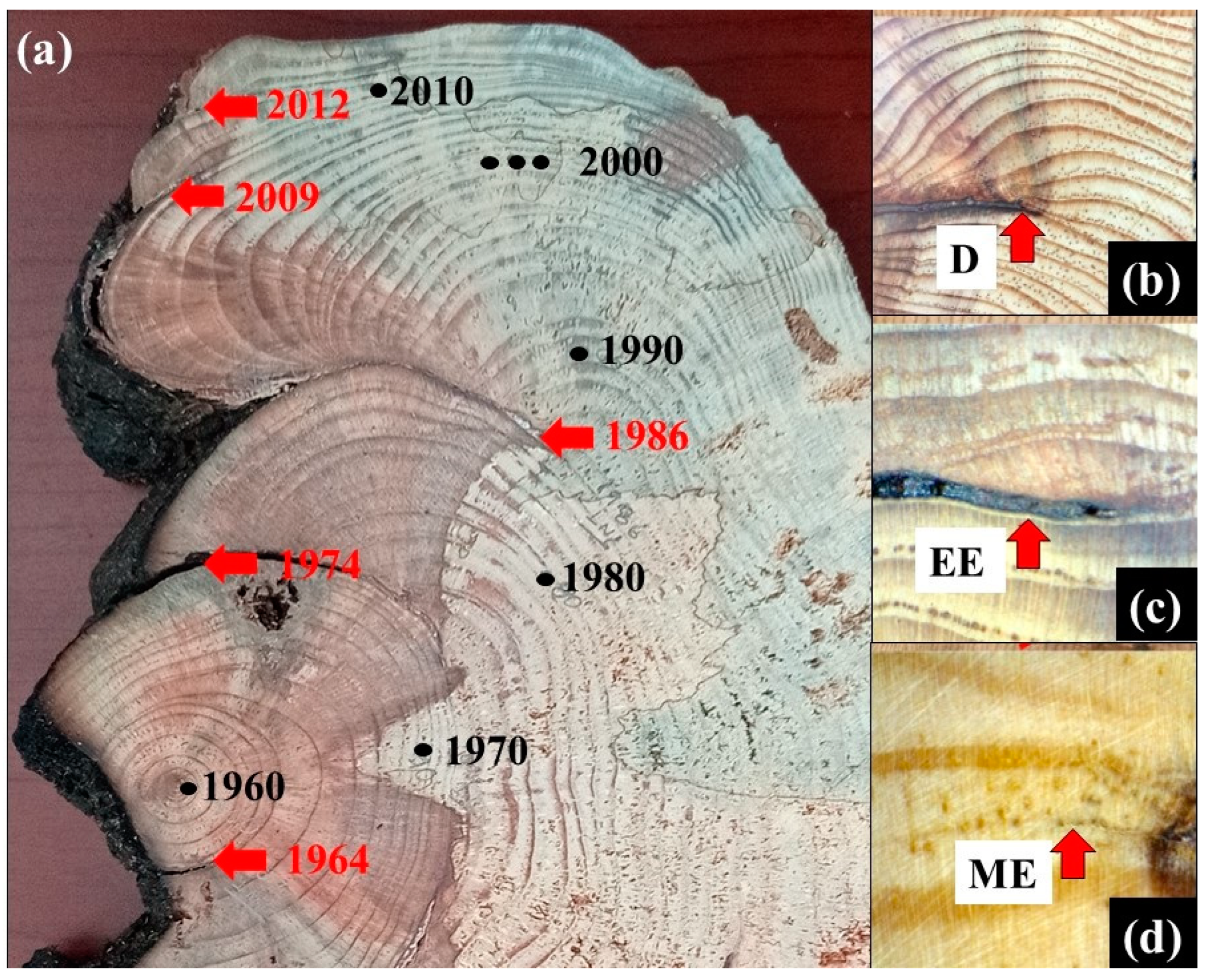
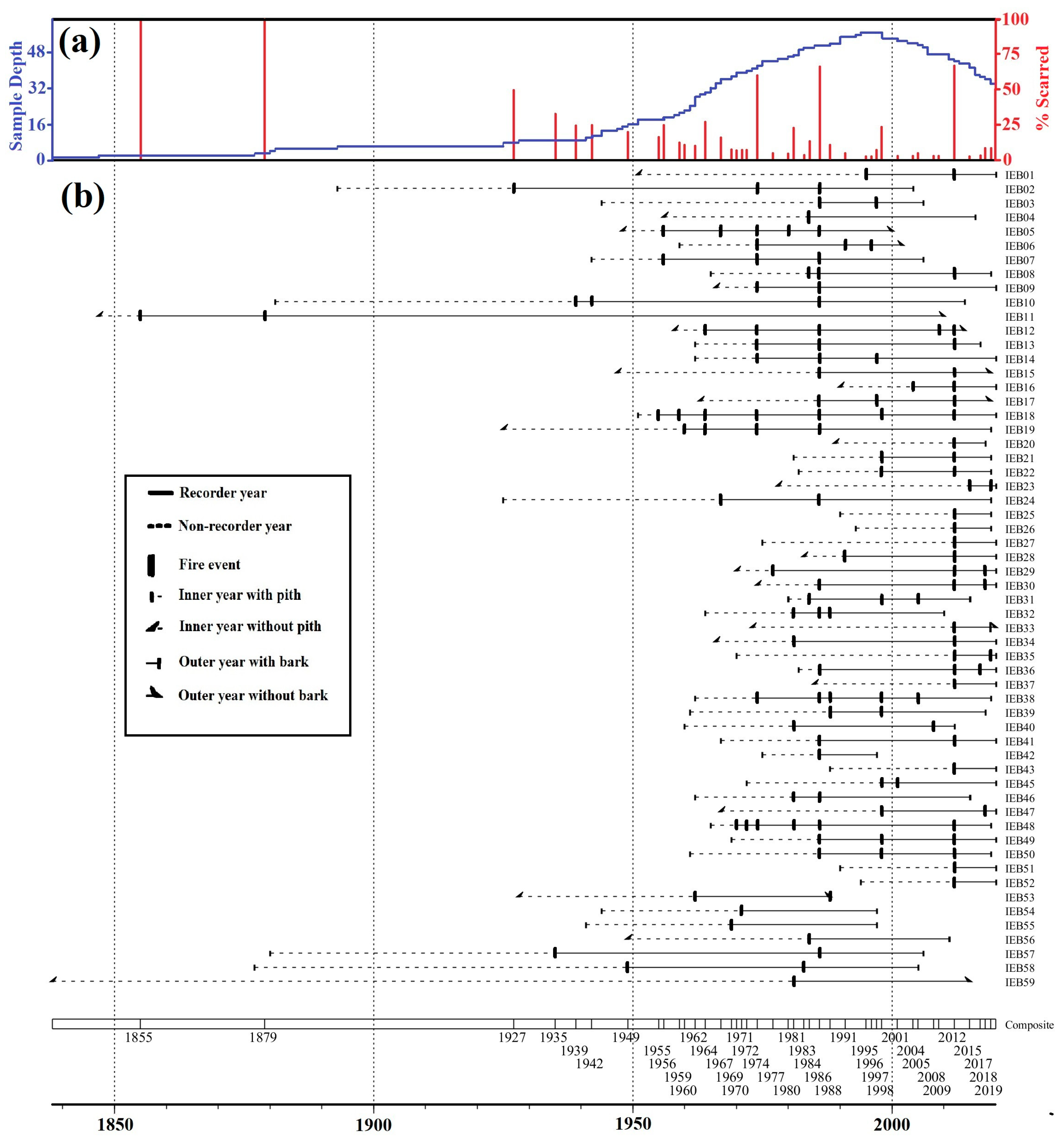
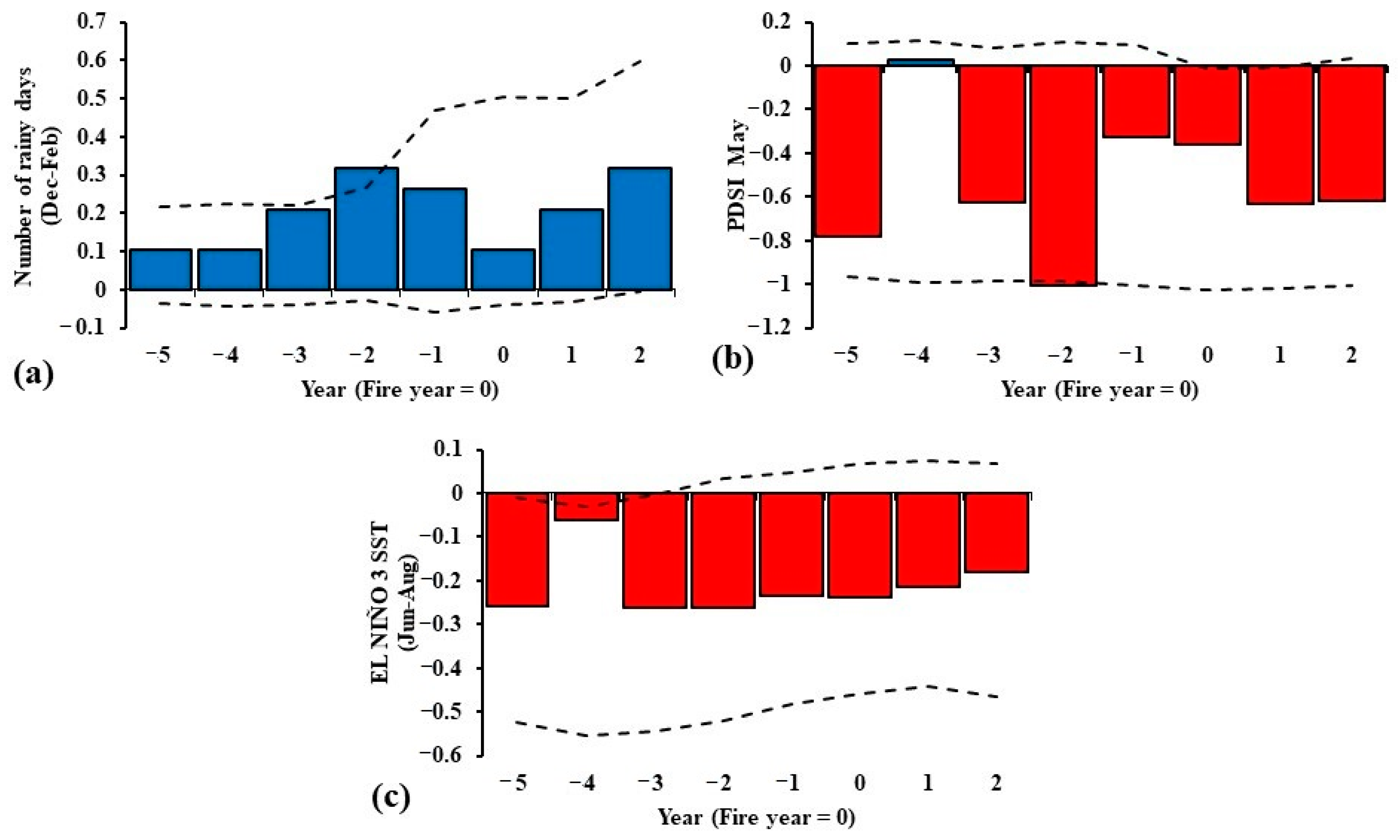
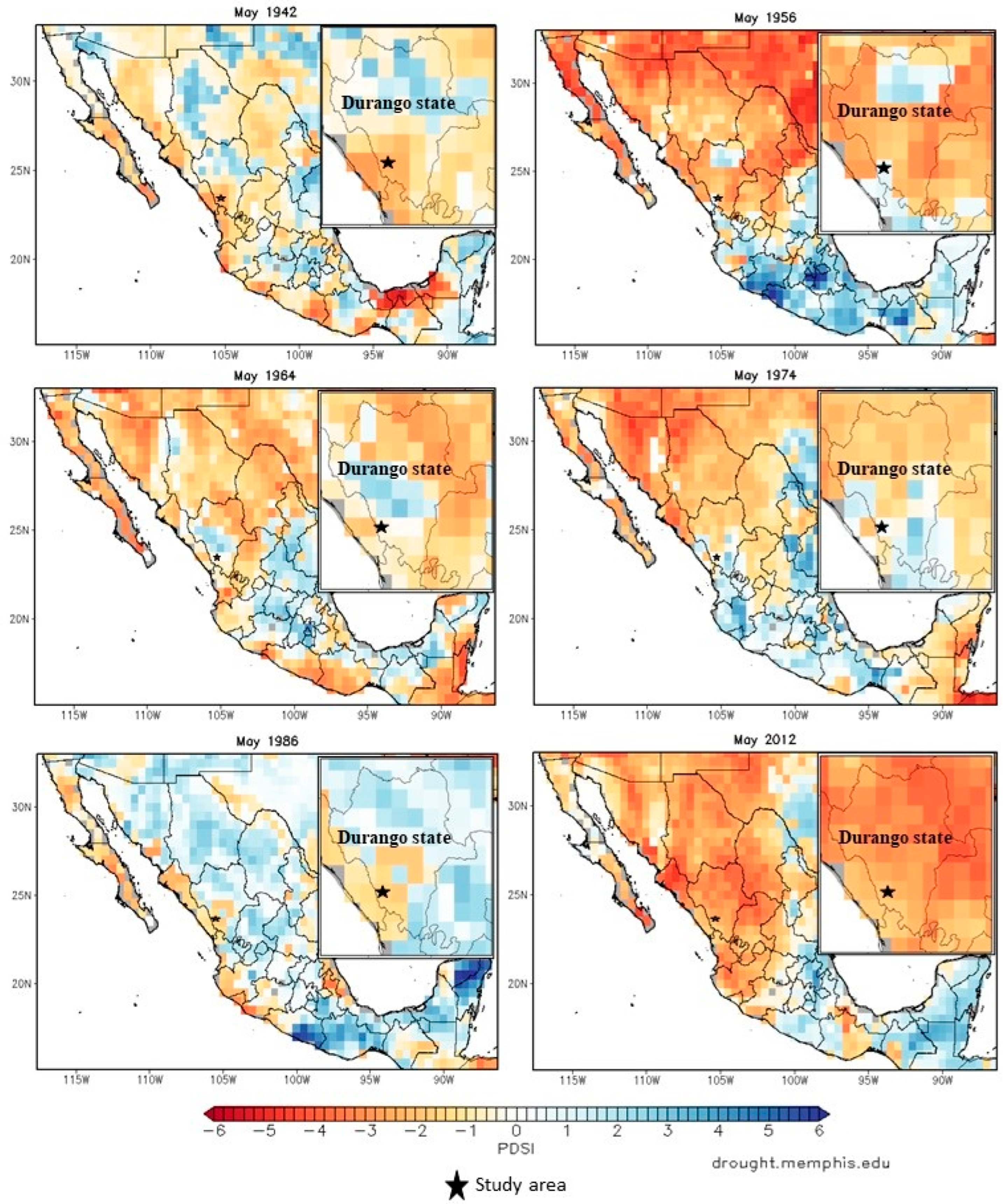

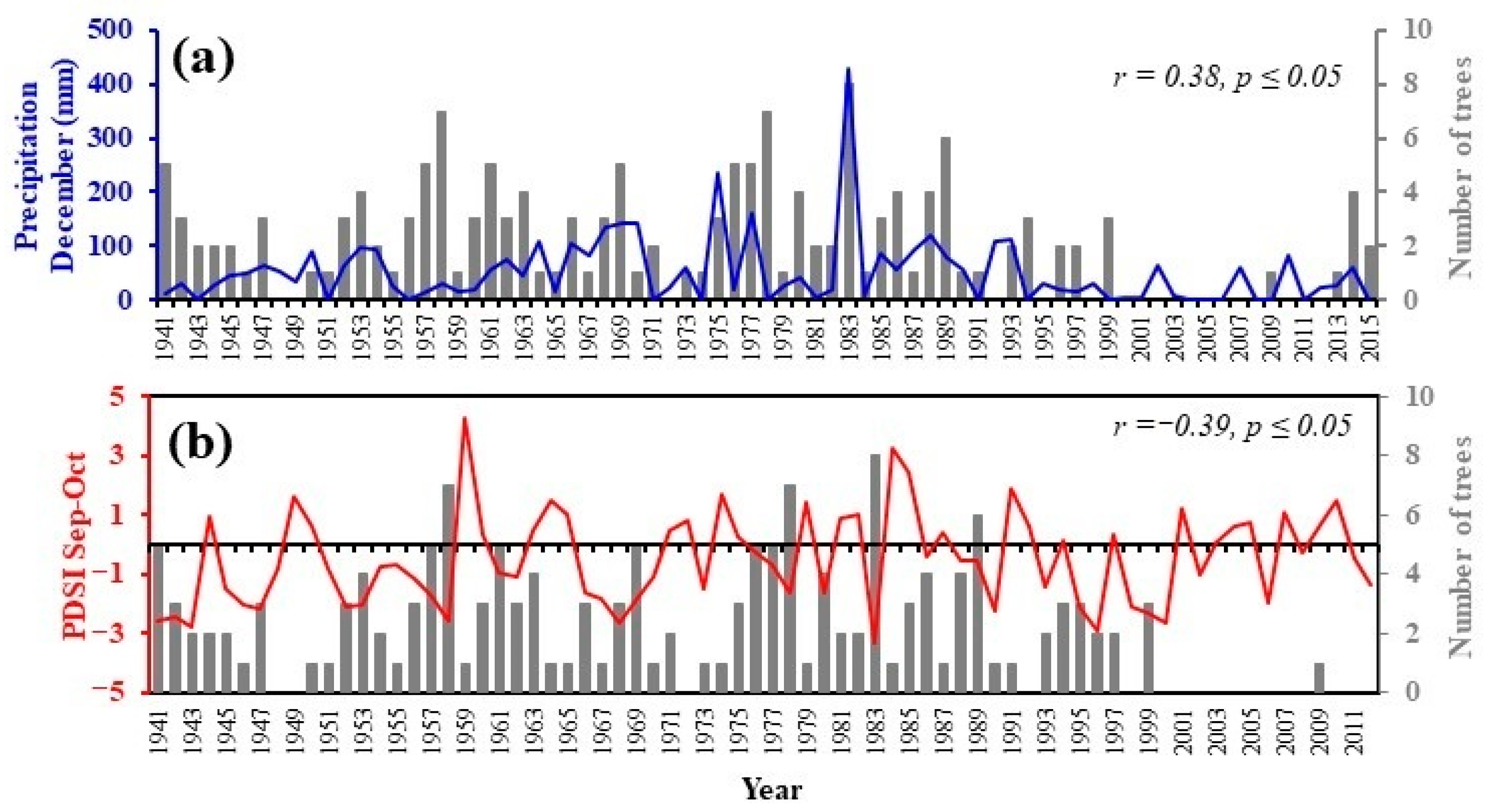
| Collected Samples | Dated Samples | Live | Dead | Stumps | Species |
|---|---|---|---|---|---|
| 60 | 58 | 19 | 11 | 28 | Pd, Pt, Ax |
| % | 96.67 | 31.67 | 18.33 | 46.67 |
| Period of Analysis | Fire Interval Filter | Number of Intervals | MFI | Min | Max | WMPI |
|---|---|---|---|---|---|---|
| 1855–2019 | All scars | 41 | 4.02 | 1 | 48 | 2.4 |
| ≥10% | 21 | 7.86 | 1 | 48 | 5.27 | |
| ≥25% | 11 | 15 | 3 | 48 | 12.43 | |
| 1940–2015 | All scars | 32 | 2.28 | 1 | 7 | 2.09 |
| ≥10% | 16 | 4.56 | 1 | 14 | 3.87 | |
| ≥25% | 6 | 12.17 | 3 | 26 | 11.21 |
| Scars | Determined Seasonality | Undetermined Seasonality | D | EE | ME | LE | L | Spring Fires | Summer Fires |
|---|---|---|---|---|---|---|---|---|---|
| Number | 137 | 0 | 22 | 52 | 54 | 3 | 6 | 74 | 63 |
| Percentage (%) | 100 | 0 | 16.1 | 38 | 39.4 | 2.2 | 4.4 | 54.01 | 45.99 |
Disclaimer/Publisher’s Note: The statements, opinions and data contained in all publications are solely those of the individual author(s) and contributor(s) and not of MDPI and/or the editor(s). MDPI and/or the editor(s) disclaim responsibility for any injury to people or property resulting from any ideas, methods, instructions or products referred to in the content. |
© 2023 by the authors. Licensee MDPI, Basel, Switzerland. This article is an open access article distributed under the terms and conditions of the Creative Commons Attribution (CC BY) license (https://creativecommons.org/licenses/by/4.0/).
Share and Cite
Zúñiga-Vásquez, J.M.; Villanueva-Díaz, J.; Cerano-Paredes, J.; Quiñonez-Barraza, G. Impact of Fire History on the Structure of a Temperate Forest in Northern Mexico. Fire 2023, 6, 19. https://doi.org/10.3390/fire6010019
Zúñiga-Vásquez JM, Villanueva-Díaz J, Cerano-Paredes J, Quiñonez-Barraza G. Impact of Fire History on the Structure of a Temperate Forest in Northern Mexico. Fire. 2023; 6(1):19. https://doi.org/10.3390/fire6010019
Chicago/Turabian StyleZúñiga-Vásquez, José M., José Villanueva-Díaz, Julián Cerano-Paredes, and Gerónimo Quiñonez-Barraza. 2023. "Impact of Fire History on the Structure of a Temperate Forest in Northern Mexico" Fire 6, no. 1: 19. https://doi.org/10.3390/fire6010019
APA StyleZúñiga-Vásquez, J. M., Villanueva-Díaz, J., Cerano-Paredes, J., & Quiñonez-Barraza, G. (2023). Impact of Fire History on the Structure of a Temperate Forest in Northern Mexico. Fire, 6(1), 19. https://doi.org/10.3390/fire6010019







